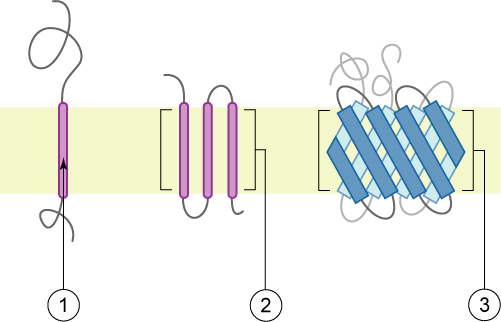|
Sodium–hydrogen Antiporter
The sodium–hydrogen antiporter or sodium–proton exchanger (Na+/H+ exchanger or NHX) is a membrane protein that transports Na+ into the cell, and H+ out of the cell (antiport). Function They are found in the membranes of many cells, and especially in those of the nephron of the kidney, specifically in the intercalary cells of the collecting duct and in the epithelial cells of the proximal convoluted tubule. The membrane pump is primarily responsible for maintaining homeostasis of pH and sodium. Defects in Na+/H+ antiporters may result in heart or kidney failure. Angiotensin II upregulates this antiporter in the proximal convoluted tubule in order to promote Na+ reabsorption and H+ secretion. Na+/H+ exchangers are thought to be implicated in other disorders such as hypertension. In one study, transgenic mice over expressing this membrane protein were shown to have increased reabsorption and retention of sodium after increased salt intake. In dopamine receptor signalling, the ... [...More Info...] [...Related Items...] OR: [Wikipedia] [Google] [Baidu] |
Membrane Protein
Membrane proteins are common proteins that are part of, or interact with, biological membranes. Membrane proteins fall into several broad categories depending on their location. Integral membrane proteins are a permanent part of a cell membrane and can either penetrate the membrane (Transmembrane protein, transmembrane) or associate with one or the other side of a membrane (Integral monotopic protein, integral monotopic). Peripheral membrane proteins are transiently associated with the cell membrane. Membrane proteins are common, and medically important—about a third of all human proteins are membrane proteins, and these are targets for more than half of all drugs. Nonetheless, compared to other classes of proteins, determining membrane protein structures remains a challenge in large part due to the difficulty in establishing experimental conditions that can preserve the correct (Native state, native) Protein structure, conformation of the protein in isolation from its native ... [...More Info...] [...Related Items...] OR: [Wikipedia] [Google] [Baidu] |
SLC9A6
Sodium/hydrogen exchanger 6 is an integral membrane protein that in humans is encoded by the ''SLC9A6'' gene. It was originally thought to be a mitochondrial-targeted protein, but subsequent studies have localized it to the plasma membrane and recycling endosomes Endosomes are a collection of intracellular sorting organelles in eukaryotic cells. They are parts of the endocytic membrane transport pathway originating from the trans Golgi network. Molecules or ligands internalized from the plasma membra .... Loss of function causes Christianson syndrome. See also * References Further reading * * * * * Solute carrier family {{membrane-protein-stub ... [...More Info...] [...Related Items...] OR: [Wikipedia] [Google] [Baidu] |
Proton Antiporter-3
A proton is a stable subatomic particle, symbol , H+, or 1H+ with a positive electric charge of +1 ''e'' (elementary charge). Its mass is slightly less than the mass of a neutron and approximately times the mass of an electron (the proton-to-electron mass ratio). Protons and neutrons, each with a mass of approximately one dalton, are jointly referred to as ''nucleons'' (particles present in atomic nuclei). One or more protons are present in the nucleus of every atom. They provide the attractive electrostatic central force which binds the atomic electrons. The number of protons in the nucleus is the defining property of an element, and is referred to as the atomic number (represented by the symbol ''Z''). Since each element is identified by the number of protons in its nucleus, each element has its own atomic number, which determines the number of atomic electrons and consequently the chemical characteristics of the element. The word ''proton'' is Greek for "first", and ... [...More Info...] [...Related Items...] OR: [Wikipedia] [Google] [Baidu] |
Proton Antiporter-2
A proton is a stable subatomic particle, symbol , H+, or 1H+ with a positive electric charge of +1 ''e'' (elementary charge). Its mass is slightly less than the mass of a neutron and approximately times the mass of an electron (the proton-to-electron mass ratio). Protons and neutrons, each with a mass of approximately one dalton, are jointly referred to as ''nucleons'' (particles present in atomic nuclei). One or more protons are present in the nucleus of every atom. They provide the attractive electrostatic central force which binds the atomic electrons. The number of protons in the nucleus is the defining property of an element, and is referred to as the atomic number (represented by the symbol ''Z''). Since each element is identified by the number of protons in its nucleus, each element has its own atomic number, which determines the number of atomic electrons and consequently the chemical characteristics of the element. The word ''proton'' is Greek for "first", and ... [...More Info...] [...Related Items...] OR: [Wikipedia] [Google] [Baidu] |
SLC9A8
Sodium/hydrogen exchanger 8 is a protein that in humans is encoded by the ''SLC9A8'' gene. See also * Solute carrier family The solute carrier (SLC) group of membrane transport proteins include over 400 members organized into 66 families. Most members of the SLC group are located in the cell membrane. The SLC gene nomenclature system was originally proposed by the HUGO ... References Further reading * * * * * * * * * Solute carrier family Genes mutated in mice {{membrane-protein-stub ... [...More Info...] [...Related Items...] OR: [Wikipedia] [Google] [Baidu] |


